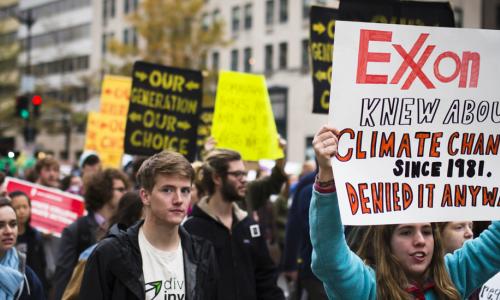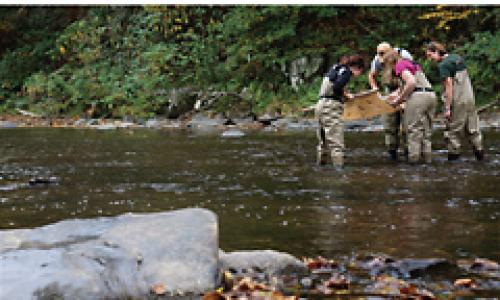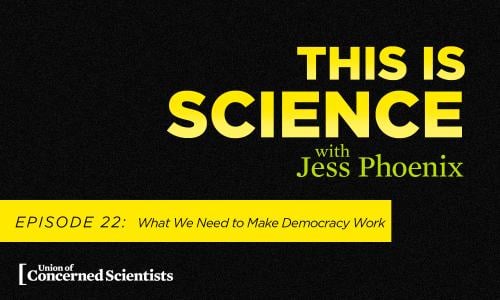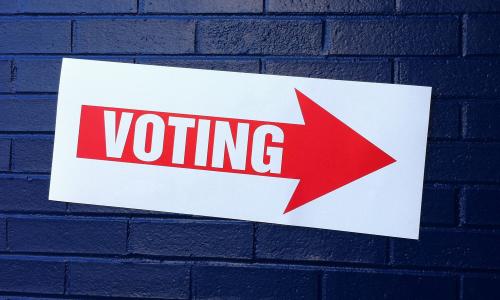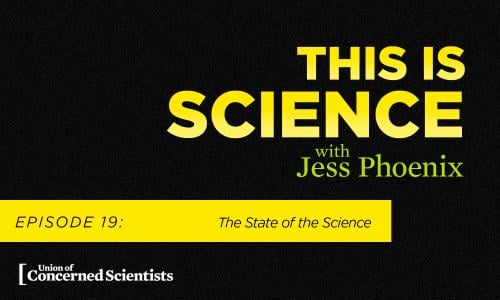Note: Both Holstun and McCluskey are speaking in their personal capacity and not on behalf of SUNY Buffalo.
Learn more about people like James Holstun and Martha T. McCluskey who have felt the effects of the Disinformation Playbook firsthand—and are taking action against it.
How did you first learn about the potential conflict of interest of the Shale Resources and Society Institute at University of Buffalo and what was your initial reaction?
JH: From a report by Mr. Buck Quigley in Artvoice, and from research conducted by the Public Accountability Initiative. My initial reaction was a desire to know the source of funding; whether it had been founded in accordance with university procedures for establishing institutes and research centers (it had not), and the scholarly quality and integrity of its flagship publication (very shoddy, as the PAI report indicated).
MTM: I have been working on issues of industry ties corrupting academic integrity, both at the University at Buffalo and nationally (as a Member Scholar at the Center for Progressive Reform, www.progressivereform.org, which does work on “clean science”). The SRSI suddenly appeared right at the time the Governor was considering fracking policy, without going through academic channels and when some other faculty-led academic institutes or centers were struggling for funds, so that was a red flag. I had been building local networks on non-transparent industry influence at UB, through involvement in our union and Faculty Senate and local economic justice groups. I learned the details of SRSI’s flaws from the quick and expert report p by one group in this network, The Public Accountability Initiative (PAI), and the good reporting of a local alternative newsweekly journalist, Buck Quigley.
My reaction was that this was another example of erosion of academic excellence and integrity due to industry ties, and evidence of the need for better policies and for attention and action and questioning.
What was the nature of the relationship between UB and the fossil fuel industry? What made the SRSI different from other research centers at the university?
JH: We still don’t know this. We know that the fossil fuel industry secretly subsidized a pro-hydrofracking conference that kicked off SRSI, but we do not yet know whether or not fossil fuel money, laundered through (and made invisible and untraceable by) the University at Buffalo Foundation, underlay the entire project.
MTM: Everything about SRSI seemed contrary to academic excellence and integrity. Its creation followed a university shale lecture event that featured gas industry ties and speakers without disclosure of funding. Then the institute appeared suddenly (without notice or information circulated to faculty who did related scholarship (law, health sciences)) and without following university policies for faculty involvement in creation of academic centers or programs. The Director of the center seemed to have very weak academic credentials and to have been hired without going through academic vetting and without disclosure.
Immediately after the institute appeared out of the blue, it issued a report (its sole publication, on environmental compliance in Penn.), which was then quickly distributed as Congressional testimony. The process therefore appeared to be an act of public relations rather than academic work – there was no presentation to UB faculty or students of the research or report, no opportunity to offer feedback or discussion, no appearance of openness to improvement or academic inquiry.
None of the authors were UB faculty. Beyond that, the report differed from others issued by academic centers or institutes at UB because it was issued as a report of UB itself – the institution -- rather than simply being identified as scholarship of the individual authors. Further, UB’s public relations channels highlighted the report as a UB product and actively distributed it under UB’s name, including in political channels.
Once PAI revealed the inconsistencies, mistakes, and weakness of the report, neither the Institute nor the authors made any effort to respond professionally to the criticisms, correct the blatant mistakes, or engage in any meaningful debate. It was clear the report was purely about public relations, and that the authors had no interest in exploring the questions or evidence.
How did the UB CLEAR group first get organized and what were its goals?
JH: Email and face-to-face communication among UB faculty, students, and staff, and members of the community. People who were friends already; people who became friends. At first, we focused primarily on establishing transparency regarding the funding, leadership, and goals of SRSI. Later, after intransigence of the UB Administration regarding these normal scholarly queries, we shifted to calling for its shutdown.
MTM: This group grew out of the looser networks I (and some others) had been building before this issue arose. We had been building relationships with local journalists and other local activist groups. We already knew that internal university channels were not functioning with integrity, that most faculty and students were unwilling to ask hard questions or “rock the boat,” so we knew that we needed to leverage outside pressure.
The journalists advised us that to get media coverage we would need to go beyond students and faculty to show a broader public concern – impact outside the university. This Shale issue, unlike some others, immediately concerned local environmental groups who were already active on fracking policy. By reaching out to them and joining forces, we had an effective alliance and a good public story: both “neutral” academics concerned mainly about scientific integrity, academic independence, and open inquiry (some of us not against fracking), and grassroots activists and organized environmental groups focused on blocking fracking in their communities.
Our goal was to ensure fracking policy was not dictated by industry interests, but by evidence and reason and attention to the impact on the community.
What do you think made UB CLEAR’s efforts to restore integrity to the university successful?
JH: The diversity of our coalition—our various skills came together nicely in the campaign; our focus on questions of scholarly integrity strangely ignored by the university administration; a petition drive aided by CREDO Mobile; a petition of university faculty; the concern of the SUNY Board of Trustees for significant and mounting damage to the reputation of the university. It was oddly pleasing to see people in the community reminding the UB Administration what academic integrity is.
MTM: An early New York Times story helped a lot – environmental reporters/ bloggers were already focused on fracking, so we were able to tie this into a broader national story. Other journalists, such as the Buffalo-based nonprofit Investigative Post along with PAI also kept attention on story. We brought together a wide range of experts and groups – highly credentialed scientists and queer student activists concerned about the university squeezing students to benefit industry. We had a faculty leader and student leader who devoted a lot of their time and brilliance. The students were great at humor and graphics and media.
We reached out to a lot of networks we already were involved with – working with existing groups is key! We got great support from leading experts from Center for Progressive Reform, from the national AAUP, which had recently issued a report on industry-academic partnerships (past president gave a UB presentation on academic integrity & industry influence, giving history of tobacco industry). That helped with publicity.
Also key was understanding where the direct power was – the SUNY statewide Trustees – and their leverage points: a) bad SUNY publicity from national news, mobilized by the fracking activists b) at the same time casting the problem as bad science and academic integrity (beyond the fracking issue).
As a result of Trustees’ pressure, the university shut down the institute and replaced it with a more plausible academic program broadly focused on energy, but that program’s future seems uncertain, perhaps because its vision and programs may still be an imperfect mix of academic faculty interests and top-down administrative or external interests.
Although it was important to shut down the Institute, we had also pushed for the University to develop policies going forward on conflicts of interest, on fundraising from industry, and on academic control of academic centers. The University set up a committee to develop these policies but it never followed through, consistent with past practices of inactive committees with passive members unwilling to ask questions or do anything except curry favor with the leadership. In this sense, we did not succeed.
On the other hand, we showed industry interests and the University that they may be accountable to the public. When students, faculty, and the community have raised other questions of UB’s academic integrity since then, the Shale Institute example probably helps remind the University leadership to be more careful about risks to their credibility and to make some good changes. Further, the alliances we built have helped address ongoing problems.
What can academic institutions and companies do to avoid abuses of research integrity in their partnerships? How can faculty and students get more involved in holding universities accountable for creating and implementing strong research integrity standards?
JH: Follow their own standards for establishing institutes and centers. Maintain integrity and transparency about funding sources. Participating actively in university governance and demand that university officers act like accountable civil servants, not unaccountable CEOs.
MTM: See the AAUP’s Industry-Academic partnership report for detailed policies and guidelines. See PAI for power-mapping resources.
Faculty and Students must be organized and talking among themselves to share concerns. They must be active in university governance and support each other in speaking out and affirming dissent. They must network with national organizations, with local activists to connect internal academic issues to broader community effects, and with journalists. They must also zero in on who holds the power, and what internal connections and divisions might be leveraged in those authorities, for example a Trustee or administrator who might have outside personal or professional connections that could lead to sympathy and support.
We must improve organizational support for those who are willing to be whistleblowers and to challenge authority and to focus on truth and justice rather than personal career gain, and not buy into efforts to portray faculty or student or community leaders as troublemakers.
